Quick search
CTRL+K
Quick search
CTRL+K
Alona beach, also known as Krinakia, is located near the exit of the Katsounaki Gorge, to the east of the Xirokambos settlement. A torrent from the gorge flows onto the Potamos beach during winter, situated adjacent to the stunning sandy beach of Alona. The beach is dotted with sand dunes, which are blanketed by white sea daffodils in the fall season. Trekking through the canyon is fairly effortless, highlighting a wild landscape with imposing walls; a trek from the top to the bottom of Alona is possible.
To the west of Alona lies another beach, Potamos, accessible by car. It’s located at the mouth of the Katsounaki river, characterized by large round pebbles. One can reach it by driving along the river towards the sea. While it may not be particularly remarkable, it offers a serene and secluded atmosphere. This beach is also referred to as Italika, named after Italian houses located on the beach.
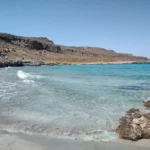
Located 500m east of Xerokambos, you will discover one of the most unique landscapes in Eastern Crete. A vast dried salt lake lies adjacent to the sea during the summer months, which may not seem particularly striking. However, visiting in the spring or winter months will reveal its true significance. During these seasons, the lake, known as Alatsolimni, or Salt Lake, fills with water and transforms into a miniature lagoon. This environment fosters the growth of thousands of microorganisms and serves as a sanctuary for migratory birds waiting for calmer winds. You may spot a variety of bird species such as herons, hawks, and flamingos.
A beautiful sandy beach with shallow waters extends in front of the lagoon, providing an ideal spot for solitude. The most opportune time to visit is early spring, when the lake is still flooded and the surrounding area is adorned with vibrant blossoms. Locals refer to this area as Alykes, which translates to saltpans, a name derived from the form of the shallow waters.
Opposite the bay, the islets of Kavali provide a suitable habitat for the Falco eleonorael. Other species in the area include the Falco peregrines, Aquila chrysaetos, and Hieraaetus fasciatus. During migration, the area is also frequented by the vulture Neoprhon percknopterus.
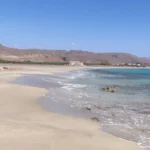
The remote settlement of Xerokambos is nestled 103km southeast of Agios Nikolaos, 47km south of Sitia, and 69km east of Ierapetra in the Lassithi prefecture. It is primarily accessible via the road that links the cities of Sitia and Ierapetra with Ziros. An alternative route is the asphalt road from Zakros. The journey from Ziros unveils lush green plateaus, abandoned medieval towns like Etia and Chametoulio, and offers breathtaking views of the South Cretan Sea and the rugged Gorge of Lamnoni.
The stark, eerie landscape of Xerokambos is defined by barren rocks and towering mountains. Its sparse vegetation consists mainly of shrubs, with occasional olive groves. Despite its isolation, it has begun to evolve into a small tourist destination, especially after the roads were paved. Xerokambos, ideal for a peaceful retreat, is not recommended for those seeking nightlife. The village offers several accommodations, mini markets, and taverns, while a pharmacy, butcher, and petrol station are available in Zakros, a 15-minute drive away.
The serene sea and beautiful beaches of Xerokambos contrast sharply with the wild mountainous backdrop. The region offers a variety of beaches, including rocky, pebbly, sandy, and even a clay beach for natural spa enthusiasts.
The main region of Xerokambos, Ambelos, lies east of Cape Trahilos. This is where you’ll find the majority of accommodations and taverns. A picturesque blue-domed church, Saint Nicholas, and the remnants of the Hellenistic city of Ambelos are also sights to behold on a nearby hill. The first beach here, Gerontolakkos, or Agios Nikolaos, is followed by a narrow argillaceous beach where visitors often engage in mud baths. This beach is aptly named Argilos, which translates to clay.
Further along is Vourlia, a small bay featuring golden sand and local accommodations and taverns. From here, the coastline becomes rockier, stretching northeast through a protected area for the white sand Lilly.
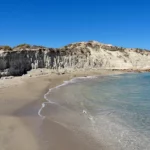
A 500-meter journey west from the Xerokambos settlement will lead you to the area’s initial hotels and the expansive beach of Mazida Ammos, the longest in Xerokambos. This stunning beach boasts white sands and crystal-clear shallow turquoise waters. To the east, it’s well shielded by Cape Trachilos, at whose tip you’ll find a sea cave named Fokiospilio. Across from Mazida Ammos, you’ll spot the minor islets known as Kavali.
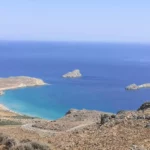
Kato Zakros, a quaint fishing village, is nestled 107km east of Agios Nikolaos and 40km east of Sitia. It serves as the scenic port of Ano Zakros village, which is located 7km to the west, amidst a fertile valley bordered by rugged mountains and lush olive groves. This remote corner of Crete provides the perfect escape for those seeking tranquillity and an escape from the bustling city life, making it a favourite among families.
The village, though small, offers all the fundamental amenities without the trappings of luxury. The villagers primarily focus on the production of world-class olive oil. Rich in archaeological sites, including the renowned Minoan palace of Zakros, the village retains its natural beauty with limited construction. However, you will find a few accommodations, taverns, mini markets, pharmacies, and petrol stations. Regular bus services from Sitia also connect the village. The warm and welcoming locals will make you feel right at home.
The serene beach fringing the village is nestled within a large protected bay. Comprising mainly pebbles and occasional rocks, the beach boasts tranquil waters, offering a peaceful retreat even during the busy month of August. The rocky seabed is a paradise for fishing enthusiasts.
When in Kato Zakros, the famous Gorge of Zakros, ominously known as Deads’ Gorge, is a must-visit. Named after the many Minoan graves discovered within its cavernous sides, the gorge offers an adventurous hike from Zakros village that takes around two hours. The Minoan palace of Zakros, the fourth largest after Knossos, Phaestus, and Malia, is a significant archaeological site located near the gorge’s exit. It houses numerous artistic masterpieces from 1900BC and is open to the public, with the most significant findings displayed at the Archaeological Museum of Heraklion.
An old dirt road leading to Zakros, offering breathtaking views of the Gorge’s steep cliffs, is worth exploring if you have a car. Upon reaching the village, take a leisurely stroll through its narrow streets and visit its churches. The springs of Zakros, forming a small oasis amidst the wild landscape of Eastern Crete, are also worth a visit.
If time permits, a boat trip (or rigorous hike) to the secluded Cave of Pelekita could be an exciting expedition. As one of Crete’s largest caves, it has traces of Neolithic habitation. A nearby quarry, presumably used by the Minoans for constructing the palace of Zakros, is also an interesting sight.

The first beach you encounter when heading west in Xerokambos is Amatos harbour. It’s a naturally encompassed harbour featuring tranquil water. The beach, although remote, is pebbly and offers an ideal environment for spearfishing. Few tamarisk trees dot the landscape and there’s a ramp to facilitate boat launching. An accessible dirt road connects the harbour to the Xerokambos settlement, from which the path to Agia Irini beach starts.
Heading from the harbour to the Xerokambos settlement, after about 100 metres, you stumble upon a hidden bay. It’s filled with fine grey pebbles and has a smaller cove nearby. This area, known as Ligias Lakkos, can be reached via a stone path that winds through the towering cliffs that surround it. The landscape is breathtaking; rugged mountains tower behind you, a peaceful harbour is on your right, and the Kavalli islands are to your left.
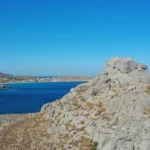
The quaint and secluded village of Agia Irini is nestled 98km southeast of Agios Nikolaos and 11km south of Ziros village. Accessible through dirt tracks originating from either Kalo Horio or Hametoulo, the village is the gateway to the rugged Agia Irini gorge, which leads to a hidden cove across from the tiny islet of Hamili.
The beach boasts pebble shores and pristine blue waters, making it one of Crete’s most remote beaches. Its location away from bustling city centres, shrouded by towering cliffs and jagged rocks, makes it a serene escape. To reach this beach, one can either navigate the formidable gorge, drive along the dirt track from the village or sail by boat from Goudouras or Xerokambos. The beach is lined with tamarisk trees, offering a perfect spot for solitude. A trail also extends from Agia Irini Gorge to Xerokambos harbour.
The Agia Irini gorge consists of two parallel canyons that converge near the sea, where the dirt road to the beach lies. The canyons, with their rocky terrain, steep inclines and towering walls, offer a wild and untamed landscape. The westernmost canyon, in particular, can be quite daunting and risky for inexperienced hikers. A hike through the gorge, starting at an altitude of 500m near the Hametoulo settlement and descending to sea level, can take between 2-3 hours and can be quite strenuous on the knees.
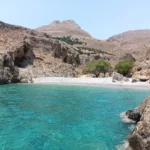
If you journey eastward from Vlyhada beach at Livari near Goudouras for about an hour, you’ll eventually stumble upon the two abandoned beaches of Tihida. The surrounding region is riddled with caves and features wall-like rock formations, hence the name Tihida (Greek for ‘wall’). These formations provide much-needed shade during the hot summer months. Further east of the smaller beach, you’ll encounter the expansive Tihida beach, which sits at the mouth of the Tihida Gorge and is somewhat challenging to access. Proceeding further eastward, you’ll discover the majestic, elongated Karavopetra rock emerging from the sea.
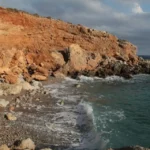
Livari, a secluded area situated 90km southeast of Agios Nikolaos and 7km east of Goudouras on Crete Island, is often a solitary spot. Just 2km east stands the power plant of Atherinolakkos, the only blemish on the otherwise pristine landscape. Livari boasts two pebbly beaches and numerous small coves, perfect for those seeking privacy or practicing naturism. While there is a lack of shade, a few tamarisk trees on the east Livari beach offer some relief.
Swimming in Livari is a unique experience, offering stunning views of the surrounding wilderness, including barren mountains, steep canyons, and the exotic island of Koufonissi. In addition to Livari’s main beach, you can drive west past a small group of 3-4 cottages to reach the lengthy eastern beach of Vlyhada. The name Vlyhada, meaning a place with brackish water, comes from a year-round spring located nearby. The beach is bordered by a dirt road and tall reddish walls.
Getting to Livari from Goudouras involves taking the road to the Atherinolakkos power station. After 4km, you’ll reach a junction where the right road leads to the factory and the local fishing lodge. Instead of taking this route, continue straight to the village of Agia Triada for another 1km until you reach a junction on the right that leads to Livari beach. The road initially starts as a paved path but eventually transitions into a manageable dirt track.
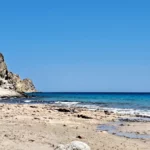
The Heromilia beach, situated in the Agia Triada region of Sitia province (also known as Tso), is just a 2km journey eastward from the Atherinolakkos Power Station. It holds the distinction of being the most western beach of the Livari beaches.
The beach forms at the mouth of the compact canyon Tripiti. The canyon derives its name from a unique hollow rock that stands a few meters north of the coastline; ‘tripiti’ translates to “with a hole.”
To reach the beach, one must descend from the summer residences of Agia Triada’s inhabitants towards the stream and then walk towards the sea. These are the first houses one encounters before reaching the main beach of Livari.
The small beach boasts clear blue waters and fine pebbles. However, its allure is somewhat marred by the Atherinolakkos Power Station. Despite this, the sea remains pristine, and the factory smoke only reaches the beach when the winds blow from the west.
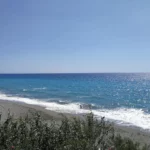
No results available
Reset© All rights reserved. Crete Locals